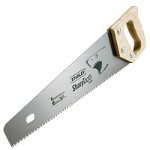Choosing the Right Saw
Author: steve Published Under: Home
 Today
Today, woodworking is beginning to become more popular again. Woodworking can not only be applied to making furniture, but also many other building and construction purposes.
There are many basic woodworking tools and the saw is one of the most important ones. The traditional hand saw remains very important, although for many cuts a power saw will also work.
Standard Hand Saws
Handsaws are made out of long strips of flexible metal, which is serrated with teeth. The length, number of teeth, and tooth size determines what the saw will be best suited for.
- Rip Saw: Rip saws are no longer manufactured in most places and are long hand saws, about 26 inches long, designed for cutting wood along the grain.
- Crosscut Saws: Crosscut saws are used to cut across the grain and are usually between 24 and 26 inches.
Panel Saw: A panel saw is very similar to a crosscut saw, except it has teeth that are much finer, making it well suited for cutting thin plywood. Panel saws are typically 20 to 22 inches long.
Back Saws
Back saws are another type of handsaw, but are stronger because a thin piece of hard metal, usually steel, is placed at the top of the blade. This makes them more rigid, so they are better suited for more accurate cuts, such as for use when cutting joints. They also usually have smaller teeth.
- Tennon Saw: Tennon saws are used to cut mortise and tenons and is the most common type of back saw. It is usually 10 to 14 inches long.
- Dovetail Saw: Dovetail saws are used to cut dovetail joints and other accurate cuts. It is much smaller than other saws usually only 8 inches long.
- Bead Saw: The bead saw is used to cut delicate moldings and beads. It features a straight handle.
Tooth size: How its Measured
The teeth of a saw is measured either in PPI, or points per inch, or TTI, teeth per inch. When comparing the two, it is important to note that there is always one less tooth per inch than there are points.
- 1-7 PPI : Heavy Duty Cuts
- 8-10 PPI: General Purpose Cuts
- 11+ PPI: Fine or more accurate cuts.
Different Types of Saw Teeth
The number of teeth on a saw, as well as how close together they are and what angle they are greatly affects the way the saw cuts.
- Rip Saw Teeth: These have a sort of chiseled appearance and do not score the wood before cutting. Should only be used for cutting wood along the grain.
- Crosscut Teeth: Knife point edge, which severs the fibers in wood. Can be used for cutting wood against the grain.
- Fleam Teeth: These are often referred to as needle teeth or straight teeth. They offer a fast cut and are well suited for softwoods. Fleam teeth are designed for cross cuts.
- Universal Teeth: These are found on both traditional handsaws and backsaws. They can be used for cutting against or along the grain.
- Aggressive Geometry Fast Cut Teeth: These teeth cut on both the front and back stroke, so produce a very quick clean cut.